The Happiest Minimalists Live by 5 Rules that Others Overlook
Minimalism isn’t a competition. It isn’t about who has the least stuff or the tidiest home. It isn’t even about decluttering for its own sake. The happiest minimalists understand something deeper: that owning less is the pathway to something...


Minimalism isn’t a competition. It isn’t about who has the least stuff or the tidiest home. It isn’t even about decluttering for its own sake. The happiest minimalists understand something deeper: that owning less is the pathway to something greater.
What you do with the space you create is what truly matters.
Over the years, I’ve noticed patterns. People who thrive in simplicity—who live with joy and freedom instead of rigidity and frustration—tend to follow a handful of quiet rules.
They aren’t flashy. They won’t go viral on social media. But they shape a minimalist life that feels whole, sustainable, and meaningful.
Here are five rules the happiest minimalists live by—rules many others overlook.
1. My minimalism will not look like yours.
The happiest minimalists release the pressure to mimic someone else’s version of minimalism. Your home doesn’t need to look like an uncluttered Pinterest board. Your wardrobe doesn’t have to fit into a suitcase. And your kitchen doesn’t need to like one featured in a magazine.
What matters is intentional alignment—your possessions serving your values. Comparison robs joy. Contentment protects it.
2. It’s okay to go slow—as long as I keep moving forward.
Decluttering in one dramatic weekend works for some, but most people build minimalism step by step. Progress doesn’t have to be fast to be meaningful.
The happiest minimalists understand that even a single drawer cleared, a single decision made, is movement toward freedom. They choose momentum over perfection.
3. I will invite, not impose.
Minimalism in a family or partnership requires grace. The happiest minimalists invite their spouses, children, and loved ones into the journey—but never with force.
They model, encourage, and create space. They trust others will join when ready. Love outlasts clutter, and forcing change is never worth the cost of peace.
4. I will not stop with stuff.
Minimalism is never just about closets and garages. It’s about how you spend your hours, how you direct your energy, what you say yes and no to. The happiest minimalists know that once the excess is gone, what remains is time and focus. And they choose to invest those in pursuits that matter: family, faith, creativity, contribution, service.
Owning less becomes the doorway, not the destination. As a matter of fact, here’s a list of 15 other places to apply minimalism other than physical possessions.
5. I will find joy in enough.
Consumer culture is built on dissatisfaction. There’s always a newer model, a better upgrade, a shinier version of what you already own.
The happiest minimalists learn to step out of that race. They stop asking, “What’s missing?” and start asking, “What’s here, and how can I love it well?” Gratitude becomes their compass, and enough becomes their culture.
Minimalism without life-giving rules can feel like joyless. But with them, it feels like freedom.
The happiest minimalists don’t measure success by how much they’ve thrown away, but by how much more fully they can live. They’ve chosen a path most people overlook—one where owning less makes space to experience more.
And that’s the secret: simplicity is never really about stuff. It’s about the life you create once the stuff is no longer in the way.

 MikeTyes
MikeTyes 































